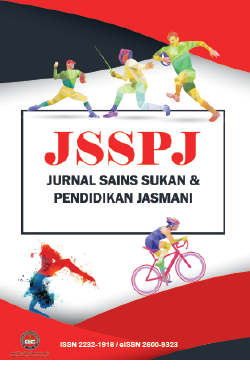Perception of Herbs Used in Sport: Pre-Study among Coaches and Athletes
DOI:
https://doi.org/10.37134/jsspj.vol10.2.5.2021Keywords:
Perception of herbs, Malaysian herbs, coach, athleteAbstract
This study was meant to identify a certain level of knowledge in using herbs amongst coaches and athletes. Herbs are a natural product that can increase human body performance. For example, most people know that herbs like ginseng if taken in small measures help people in sexual performance, and that ulam raja can be used as an ingredient in beauty products. However, they are not aware of other secret properties in herbs that can increase athletes’ performance or human body metabolism. Data were collected from 50 coaches (from MSN) and 30 athletes (from UiTM). All 50 coaches were represented by 25 males and 25 females, as for the athletes (individual game), they were divided into 15 males and 15 females. The data was collected using ‘Perception of Using Herbs amongst Coaches and Athletes’ and also interviews. All data have been analyzed using descriptive analysis. We have concluded that most of the respondents are not aware of or have no good knowledge about herbs being used in sports to improve athletes’ performance. The percentage of the herbs-knowledge survey has shown 56.7% (17) as undecided. In the survey, 33.3% (1) gave no as an answer, whereas others who responded with yes were 40% (12). From this finding, all participants mainly assume that herbs can only increase the release of sexual hormones and can influence sexual potency; but instead, they should think that taking herbs can also improve human body performance. Nevertheless, this study provides an understanding of how herbs can be taken and applied as a cure or remedy in sports.
Downloads
References
Abas, H. (2001). Adverse effects of herbs and modern drug-herbal interactions In Towards Bridging Science and Herbal Industry: Proceedings of the Seminar on Medicinal and Aromatic Plants, 12-13 September 2000 (p. 32). Forest Research Institute Malaysia.
Alraei, R. G. (2010). Herbal and dietary supplements for weight loss. Topics in Clinical Nutrition, 25(2), 136-150.
Altman, R. D., & Marcussen, K. C. (2001). Effects of a ginger extract on knee pain in patients with osteoarthritis. Arthritis & Rheumatism, 44(11), 2531-2538.
Barnett, W. S., Bernal, R., & Nores, M. (2020). The contributions of economics to early childhood education and care. Scientific Influences on Early Childhood Education, 119-131.
Bhatt, N., Waly, M. I., Essa, M. M., & Ali, A. (2013). Ginger: A functional herb. Food as Medicine, 51-71.
Black, C. D., Herring, M. P., Hurley, D. J., & O'Connor, P. J. (2010). Ginger (Zingiber officinale) reduces muscle pain caused by eccentric exercise. The Journal of Pain, 11(9), 894-903.
Braun, L., & Cohen, M. (2015). Herbs and natural supplements, volume 2: An evidence-based guide (Vol. 2). Elsevier Health Sciences.
Bucci, L. R. (2000). Selected herbals and human exercise performance. The American Journal of Clinical Nutrition, 72(2), 624S-636S.
Chen, C. K., Muhamad, A. S., & Ooi, F. K. (2012). Herbs in exercise and sports. Journal of Physiological Anthropology, 31(1), 1-7.
Cichoke, A. J. (2001). Secrets of Native American herbal remedies: a comprehensive guide to the Native American tradition of using herbs and the mind/body/spirit connection for improving health and well-being. Penguin.
Cohen, L., Manion, L., & Morrison, K. (2017). Validity and reliability. In Research methods in education (pp. 245-284). Routledge.
Fatima, N., & Nayeem, N. (2016). Toxic effects as a result of herbal medicine intake. Toxicology-New Aspects to This Scientific Conundrum. London, UK: InTech Open, 193-207.
Gardiner, P., Kemper, K. J., Legedza, A., & Phillips, R. S. (2007). Factors associated with herb and dietary supplement use by young adults in the United States. BMC Complementary and Alternative Medicine, 7(1), 1-7.
Huda-Faujan, N., Noriham, A., Norrakiah, A. S., & Babji, A. S. (2007). Antioxidative activities of water extracts of some Malaysian herbs. ASEAN Food Journal.
Institute of Medicine (US) Committee (IMC) (2005) Complementary and Alternative Medicine in the United States. National Academies Press (US).
Kundrat, S. (2005). Can Herbal supplements improve performance? Supplement. Sport Science Exchange, Vol 18(1).
Liu, L., Liu, C., Wang, Y., Wang, P., Li, Y., & Li, B. (2015). Herbal medicine for anxiety, depression and insomnia. Current Neuropharmacology, 13(4), 481-493.
Mehra, B., & Pant, G. (2017). Effect of caffeinated drink on endurance performance of the athlete. International Journal of Yoga, Physiotherapy and Physical Education. 2(3), 07-08
Nishida, S., & Satoh, H. (2004). Comparative vasodilating actions among terpenoids and flavonoids contained in Ginkgo biloba extract. Clinica Chimica Acta, 339(1-2), 129-133.
O’Leary, Z. (2014). The Essential Guide to Doing your Research Project (2nd ed.). London: SAGE
Khalsa, K. P., & Tierra, M. (2008). The way of Ayurvedic herbs: A contemporary introduction and useful manual for the world’s oldest healing system. Twin Lakes, WI: Lotus Press; 2008.
Spiteri, M. (2011). Herbal Monographs including Herbal Medical Product and Food Supplements. Print Right Ltd, Qormi
Stern, J. S., Peerson, J., Mishra, A. T., Mathukumalli, V. S. R., & Konda, P. R. (2013). Efficacy and tolerability of an herbal formulation for weight management. Journal of Medicinal Food, 16(6), 529-537.
van Baak, M. A., & Mariman, E. (2019). Dietary strategies for weight loss maintenance. Nutrients, 11(8), 1916.
Yavuz, H. U., & Özkum, D. (2014). Herbs potentially enhancing sports performance. Current Topics in Nutraceutical Research, 12.
Williams, M. (2006). Dietary Supplements and sports performance: Herbals. Journal of The International Society of Sports Nutrition, 3(1):1-6.
Woods, R. (2007). Social Issue in Sports. (pp 229). Human Kinetic (1stEdittion), USA.
Wynn, S. G., & Fougère, B. J. (2007). Veterinary herbal medicine: A systems-based approach. Veterinary Herbal Medicine, 291.
Zin, Z. M., Abdul-Hamid, A., & Osman, A. (2002). Antioxidative activity of extracts from Mengkudu (Morinda citrifolia L.) root, fruit and leaf. Food Chemistry, 78(2), 227-231.





